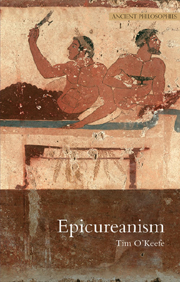Book contents
- Frontmatter
- Contents
- Preface
- Acknowledgements
- Sources and abbreviations
- Chronology
- 1 Introduction: the life of Epicurus and the history of Epicureanism
- I Metaphysics and physics: introduction and overview
- 2 Atoms and void
- 3 Atomic motion
- 4 Sensible qualities
- 5 Cosmology
- 6 Biology and language
- 7 The mind
- 8 Freedom and determinism
- II Epistemology: introduction and overview
- III Ethics: introduction and overview
- Glossary of terms
- Notes
- Further reading
- Bibliography
- Index
3 - Atomic motion
from I - Metaphysics and physics: introduction and overview
- Frontmatter
- Contents
- Preface
- Acknowledgements
- Sources and abbreviations
- Chronology
- 1 Introduction: the life of Epicurus and the history of Epicureanism
- I Metaphysics and physics: introduction and overview
- 2 Atoms and void
- 3 Atomic motion
- 4 Sensible qualities
- 5 Cosmology
- 6 Biology and language
- 7 The mind
- 8 Freedom and determinism
- II Epistemology: introduction and overview
- III Ethics: introduction and overview
- Glossary of terms
- Notes
- Further reading
- Bibliography
- Index
Summary
Weight and the swerve
Up to this point, Epicurus' atomism has largely followed the path already taken by Democritus. Since we have fairly little information about Democritus, it is possible that some of the particular arguments that Epicurus and Lucretius give for the existence of atoms are original, but the basic argument that void is necessary for there to be motion, and the characterization of atoms and void, are more or less the same.
But when accounting for atomic motion, Epicurus makes major modifications to the system he inherited from Democritus. For Democritus, atoms eternally fly through the void in all directions. They collide with and rebound from one another, occasionally becoming entangled and forming larger bodies. Atomic motion, then, is the result of inertia – although one must always be careful of anachronism when applying such terms – plus collisions.
Epicurus adds two additional causes of atomic motion. The first is weight (DRN II 184–215). For Epicurus, “weight” is simply the natural tendency of atoms to move downwards. What way is “down”? If you stand upright (no leaning!) and draw a line from the top of your head down to your feet, it is that way, below you, whereas “up” is the opposite direction. Epicurus (like Democritus) believes that the universe is spatially unlimited (we shall explore the reasons for this in Chapter 5).
- Type
- Chapter
- Information
- Epicureanism , pp. 25 - 32Publisher: Acumen PublishingPrint publication year: 2009

